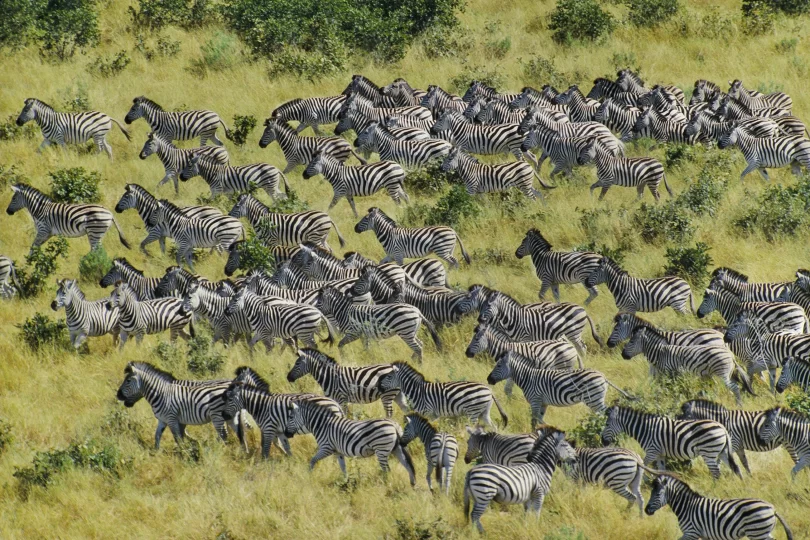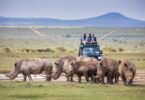Ask people to think of the greatest animal migrations in Africa and the ‘Great Wildebeest Migration’ will no doubt come to mind. However, there are several other animal migrations in Africa, on land, sea, and air.
This post explores the six most remarkable animal migrations in Africa, ranging from flamingos in Kenya to the whales off the South African coast. Of course, we include the Great Wildebeest migration of Tanzania and Kenya in this list (as it truly is one of the incredible natural wonders), but did you know Zambia has a second wildebeest migration each year?
Where is the Largest Animal Migration in Africa?
The annual Great Wildebeest Migration in Tanzania’s Serengeti is undoubtedly nature’s most wondrous spectacle and the most well-known animal migration in Africa. Most people believe the Serengeti in Tanzania to be the most dramatic migration. Depending on the timing of the rains, enormous herds of zebras, wildebeests, and gazelles migrate from Tanzania’s Ngorongoro region to Kenya’s Masai Mara and back.
Our pick of the six greatest animal migrations in Africa:
- Fruit Bat migration: Zambia

Greatest Animal Migrations in Africa; the Fruit Bat migration. Photo/
Africa Geographic
Our number one migrants are the straw-colored fruit bats (a fox-faced bat with distinctive yellow fur and a 80 cm wingspan).
Each year from late October to mid-December, Kasanka National Park Zambia hosts a migration of over 10 million straw-coloured fruit bats, as they descend into the evergreen swamp forest in Northern Zambia. Though Kasanka is one of Zambia’s smallest national parks, it has broad biodiversity because of its ecosystem of wetlands and floodplains.
Each sunset, millions of bats fly off to feed for the night. The scale of this activity is immense, with these giant bats flying in a chaotic order as far as the eye can see.
There are several viewpoints in the park, ranging from hides in trees to open public viewing spaces.
2. Zebra migration: Botswana

Greatest Animal Migrations in Africa. Photo/National Geographic
Driven by thirst, thousands of zebras in Botswana migrate in search of water and lusher grazing. As the dry season begins, zebras assemble in the Nxai and Makgadikgadi Pans before starting their 300-mile trip to the Boteti River-their promised land. zebras retrace back in November when it rains again.
This is a photogenic wildlife migration, with the zebra standing out against sun-bleached vegetation.
3. The Great Wildebeest Migration: Tanzania and Kenya.

Herds of Wildebeests. Photo/Andbeyond
The Great Wildebeest Migration is the annual migration of enormous herds of grazers across the Serengeti-Mara ecosystem. It is truly one of nature’s wonders and it is one of the most sought-after experiences for wildlife and nature enthusiasts.
Over two million wildebeest, zebras, buffalo, wildebeest, elephants, and gazelles migrate in a circuit around the Serengeti and Masai Mara in search of water and fresh pastures.
The migration is a year-round circular motion, with the herd crossing the Mara River from July to October. February is the calving season on the plains of the Ngorongoro Conservation Area where all the herds join in one giant group.
Along the way, there is always a lot of drama as thousands of animals are taken by predators and thousands more are born, filling the numbers and maintaining the circle of life.
4. Flamingo migration: Kenya

Flamingo Migration Kenya. Photo/Explore Africa
From April to June is the season for the Rift Valley’s most under-reported animal migration. Millions of Lesser and Greater Flamingos fly in from surrounding countries to breed on the warm, shallow lakes of Bogoria and Nakuru. East Africa’s flamingos fly in ‘V’ formations heading to their breeding grounds.
Seeing millions of the long-legged, pink-feathered birds landing or taking off is an exceptionally beautiful sight. If you remember the famous yellow biplane scene in the movie ‘Out of Africa’, you already know how beautiful the pink wings of flamingos can be.
Lake Nakuru and Lake Bogoria have mineral content and the waters are consequently rich in algae and tiny shrimp. This causes the flamingos to turn pink—a fetching case of ‘you are what you eat. Lake Nakuru and Lake Bogoria also have large areas shallow enough for the flamingos to wade through, with their heads turned upside down in their remarkable feeding posture.
5. Southern Right Whale migration: South Africa

Humpback Whales South Africa. Photo/National Geographic
Each year, From June to November Hermanus, South Africa becomes a whale-watching mecca as thousands of Southern Right whales arrive from their summer feeding grounds in the Antarctic. Humpback whales, with their aerial displays, long pectoral fins, and haunting undersea calls, are some of the most charismatic of all cetaceans.
These super-large and heavy animals migrate to Hermanus to mate and give birth in the sandy, sheltered bays, with females returning to the same bays to breed and give birth each year.
In November, the whales migrate back to the icy waters of the Antarctic–a 5,000-kilometre journey!
6. The wildebeest migration to Liuwa Plains, Zambia

Greatest Animal Migrations in Africa. Photo/Timbuktu Travel
They may be wildebeest, but this is not the Serengeti. Instead, we are on the Liuwa Plain National Park in Zambia. The wildebeest migration to Liuwa Plains, the far western corner, is another Greatest Animal Migration in Africa, yet it is not popular. Each year, 45,000 wildebeests migrate to fresh grazing plains in the Liuwa Plains National Park, making it the second-largest migration of wildebeests in the world. The migration follows the rains, reaching Liuwa Plains between September and November each year, so if you’re planning a visit to safari in Zambia, November is the best month to see these huge herd grazing Wildebeest migration.








